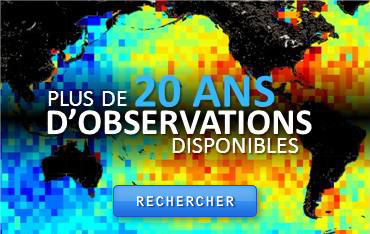Actualités
[Jason-2 GDRs]: Information about the new altimetric standard version "D"
Jason-2 OGDRs, IGDRs and GDRs will switch to a new altimetric standard (version "D") this summer. A reprocessing campaign will process the four first years of mission to provide an homogeneous GDR dataset.
Altimetric data are regularly reprocessed in order to take into account new algorithms, corrections, parameters, etc.
Since its launch in June 2008, Jason-2 products have been disseminated in version "C" (for your information, GDR products only are named "T" to stand for "GDR-C Test version" and the letter has never been updated). Jason-1 and Envisat data have been reprocessed in version "C" to have consistency between the three missions (see our <link http: www.aviso.oceanobs.com en news-storage news-detail _top external-link-new-window>news: [Jason-1 GDR-C] Reprocessing Complete).
For Jason-2, it is now time to change for another standard to benefit from many years of progress in altimetry. It means that routine data processed (OGDRs, IGDRs and GDRs) will switch to a new standard (version "D") this summer and that a reprocessing campaign will process the four first years of mission to provide an homogeneous GDR dataset.
DIFFERENCES BETWEEN VERSION "C" and VERSION "D" ALTIMETRIC STANDARD
Cnes is currently reprocessing all GDR products of the Jason-2 mission in a new altimetric standard called version "D".
The main differences between "C" and "D" standards are (for Jason-2):
- NetCDF extension (.nc) added for all Jason-2 level-2 filenames
- Absolute bias correction
- Datation bias correction
- Update of the altimeter characterisation file
- For IGDRS and GDRS, use of MOE and POE in orbitographic standard "D" (1)
- Use of GOT 4.8 global tide model instead of GOT00.2
- New reference surfaces
- New atmospheric correction algorithm provided by JPL (coastal area + new flags)
- MLE3 key parameters have been included in both GDRs and SGDRs datasets, following what has been implemented for MLE4
- New LUT (altimeter instrumental corrections tables) have been generated
- Sea State Bias tables were computed using samples of JA2 GDR_D products
- Use of a null mispointing value in input of the C band retracking algorithm
- Use of LTM information filtered over several days
- Polar tide anomaly correction
- Long period non equilibrium tide anomaly correction
- SSHA computed when meteo grid are extrapolated
- NRT orbit quality flag in OGDR products
- Ice Flag in SSHA products
- New parameters in SGDR products (including all MLE3 derived parameters)
- Some complementary evolutions (specifications updates+ typos in the products + ...)
All these modifications have been presented at Lisbon & San Diego OSTST events (respectively in 2010 and 2011) and approved by attendees and project scientists.
For more details, please refer to the <link fileadmin documents data tools hdbk_j2.pdf download>Jason-2 products handbook an see in the <link fileadmin documents data tools ja2_gdr_d_release_note.pdf download>Public Release document:
- a description of the evolutions included in GDR-D standards (see : Jason-2 GDR-D standard, page 2). Further details are available in the OSTM/Jason-2 Product Handbook document.
- a summary of the CalVal analysis performed on the formation flying cycles (see : Jason-2 GDR-D analysis, page 5). A more detailed report is also available on the Cnes/Aviso's site: <link ftp: avisoftp.cnes.fr aviso pub jason-2 documentation gdr_d_calval_report ja2_gdr_d_validation_report_cycles1to20_v1_1.pdf _blank external-link-new-window>Jason-2 reprocessing impact on ocean data (cycles 001 to 020). Comparison of Jason-2 Gdr-D with GGDR-T, as well as with Jason-1 GDR-C.
(1) There are many confusions between altimetric standard and orbitographic standard.
An altimetric standard defines algorithms/corrections/models used to process the altimetric data and defines parameters of the final products.
An orbitographic standard defines the version of the orbit models used to create MOE and POE orbits.
We try to keep the link between the numbering of altimetric and orbitographic standard but it is not easy to do. The orbit standard is often available for upgrade before the altimetric one. For example, Jason-1 benefits from orbits at the orbitographic standard "D" since its change to geodetic orbit (from cycle 500). Envisat and Cryosat-2 have also switched their orbitographic standard to "D" at the beginning of the year 2012 (see our <link http: www.aviso.oceanobs.com en news-storage news-detail _top external-link-new-window>news: [Envisat] New orbit standards in GDRs and in Ssalto/Duacs products). All details about the orbit standards are listed in Jason-2 products handbook (page 29).
SCHEDULE TO SWITCH TO NEW STANDARD
REPROCESSING CAMPAIGN
More than 50 cycles of GDR products in version "D" have been reprocessed and validated by Cnes & JPL. They will be officially released in week 30 (end of July) with a release note, the product handbook and the link to download the data. For the moment, the tandem phase with Jason-1 has been reprocessed (cycles 1-20) and extended until cycle 36, to have a complete year. Then recent cycles have also been reprocessed (cycles 123-140). The reprocessing campaign goes on and will last several months.
ROUTINE OPERATIONS
Concerning the routine operations, the schedule is:
- OGDR products, processed by NOAA and EUMETSAT, will switch to new standard on July 31st, 2012.
- IGDR products, processed by Cnes, will switch to new standard for the processing of cycle 150 (beginning July 29th, 2012). A delay is foreseen in the delivery of first IGDRs-D on the AVISO ftp due to the installation of new processing chains.
- GDR products are processed by Cnes. They will switch to new standard for the processing of cycle 146 (beginning June 19th, 2012).
We do our best for a seamless transition between altimetric standards and we are sorry in advance for inconvenience this change may cause.
For your information, note that a new way of disseminating altimetric data is under development. Our aim is to provide users with on-demand products (temporal/geographical extraction, parameters extraction, up-to-date corrections and models, database with coastal/regional products, etc.). A prototype of this new service will be shown in Venice OSTST meeting in September 2012.
Emilie Bronner
Cnes Altimetric product quality manager































